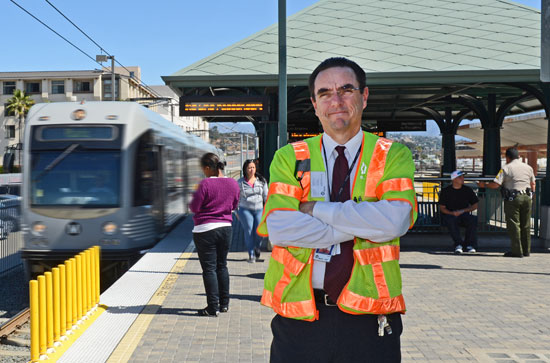Making tracks to the Westside
April 18, 2013

Metro's rail operations chief, Bruce Shelburne, says bike ridership on the trains has gone "sky high."
Bruce Shelburne is hoping for the best. But he’s bracing for “a learning experience.”
As Metro’s executive director for rail operations, Shelburne will have his hands full this Sunday, when the hugely popular CicLAvia winds its way for the first time from downtown Los Angeles to Venice, promising to pack the rail system with riders headed to points along the 15-mile route. At the same time, the Los Angeles Times Festival of Books and the Grand Prix of Long Beach will also be feeding crowds onto the rail lines.
Still, Shelburne, a 26-year Metro veteran, says he’s learned not to get overly stressed by the logistics and pitfalls of his job. “I’m learning to let go a little bit,” he says. “Otherwise you’re going to find yourself on the wrong end of a shovel, six-feet under.”
Shelburne expects one major CicLAvia hotspot to be the new Expo Line’s Culver City station, which, for now, is the closest stop to the sea. That end-of-the-line location will make it a major—and potentially clogged—entrance and exit point for people interested in traveling only along the route’s western end. Culver City’s elevated station might also complicate things because cyclists will have to carry bikes up and down stairs or crowd into elevators.
Increasing the potential congestion, CicLAvia has placed one of its “hubs” there to provide water, restrooms, and bike repairs, while Culver City and its businesses are planning a variety of entertainment options, including free massages and live music to complement food and shopping deals. A bike valet will help people make sure their wheels are secure while they browse the area.
Throughout Metro’s rapidly expanding rail system, Shelburne and his staff will also have to grapple with the reality that many CicLAvia passengers will be riding the rails for the first time and are unfamiliar with the agency’s TAP Card system, which can be confusing to the uninitiated.
“Trust me,” Shelburne says, “if that becomes a bottleneck, we’ll undo that real quick. We’ll address it with any means necessary to get people moving.”
Shelburne says that he sees CicLAvia and other major seam-stretching L.A. events as laboratories for lessons that can be applied in the future. For example, based on past CicLAvias, Shelburne says he’s doubling the number of trains on some lines. And while bikes are normally limited to two per train, Shelburne says, “we tend to look the other way on this kind of day.” In fact, Metro staffers will try to devote one car or maybe more per train to cyclists.
“It’s not all about the bikes,” Shelburne says. “We can’t take all the seats out. We have 100 million riders boarding the system annually and the majority of them don’t use bikes….The advantage is that bicyclists, especially the experienced ones, tend to work well with each other.”
(On Thursday, the regional rail service Metrolink announced it would be putting all 17 of its specially-outfitted “bike cars” into service on Sunday to serve the CicLAvia crowds. More information is here.)
While Shelburne is modest about his team’s successes managing past events, he’s particularly proud of one of his personal contributions—deploying Metro staffers to help people navigate the system and provide a human face to agency. Humor helps, too, he says. “If you’re not afraid to make a joke at your own expense, it goes a long way.”
On the future of bikes and trains in general, Shelburne sees a growing challenge and the need for a new relationship between cyclists and other passengers. “It seems like our bicycle ridership has really gone sky high,” he says.
Metro has already removed seats from older rail cars, and new cars will include additional accommodations for bicycles. But in the long term, Shelburne says, Metro will need to look at additional measures, such as arranging seats around the edges of cars to open more floor space.
While Shelburne admits he’s not one to jump on a bike very often, he does spend a plenty of time on the rails each day. He commutes from his home Oxnard to Union Station in downtown L.A.—a 70-mile trip that takes more than 90 minutes each way. On the way home, it’s a chance to catch up with work. But in the morning, he says, the smooth ride is the perfect opportunity for a pre-office nap.
“What rail buys,” he says, “is peace of mind and consistency. It just calms you down and you don’t have to worry about some of the idiots on the road.”












 405 bridge work causes a stink
405 bridge work causes a stink

